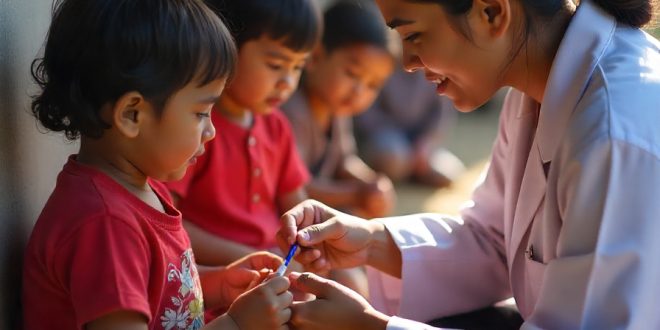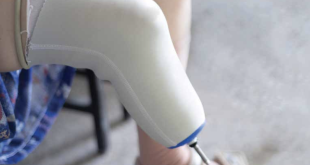 Dr Santosh Pokhrel
Dr Santosh Pokhrel
He is a pediatrician working at Butwal, Lumbini, Nepal. He completed his MD in pediatrics from the Institute of Medicine (IoM) Kathmandu in 2013. He was born and grew up in the rural hilly region of Nepal, Arghakhanchi. He decided to serve people in need from more underprivileged areas including his birth place and moved to Butwal. There, he joined Siddhartha Children and Women’s Hospital as a pediatrician. He started taking care of Type 1 Diabetic Children in 2014 with support from Life for a Child Program. Before that, most Children with type 1 Diabetes from that region were referred to Kathmandu for regular check-ups. Starting with a single child, now he is taking care of more than 100 children with Type 1 Diabetes. He aims to set up a well- dedicated Type 1 Diabetes referral center with multispecialty care in his current hospital. He has been a member of International Society of Pediatric and Adolescent Diabetes (ISPAD) since 2015. He was selected to attain the ISPAD Science School for Physicians in Oslo, Norway, in 2016. He completed his Allan Drash Fellowship in Pediatric Diabetes from Stanford University in 2022. Dr Pokhrel is also working with the Nepal Pediatric Society and the National Health Research Council to start a National registry of Type 1 Diabetes patients.
Being a General Pediatrician and practicing Endocrinology focusing on pediatric diabetes, my daily practice involves navigating the complexities of diabetes in children and adolescents. This journey of mine started 12 years ago at Siddhartha Children and Women Hospital (SCWH), Butwal. Taking care of Pediatric Diabetes is universally challenging and takes on different contours depending on the healthcare landscapes available. It’s my witness from the cutting-edge medical environments of the developed world to the resource-constrained realities of Nepal. But as a healthcare professional, the fundamental goal remains the same: to ensure the best possible outcomes for our young patients. Let’s make it clear that from the day of diagnosis, children with Diabetes need everyday insulin injections before food and a minimum of 3-4 times blood sugar level test at home daily to ensure proper management of their diabetes. These multiple daily injections of insulin and pricking of delicate fingers for monitoring sugar level make them and their care givers easily exhausted. Thus the need for regular assessment of their mental wellbeing and importance of providing psychological support, social support and individual/group counseling cannot be overemphasized.
I remember visiting Lucile Packard Children’s Hospital at Stanford University three years ago where artificial pancreas and closed loop system for insulin pump and Continuous Glucose monitoring (CGM) were on the top of the talk avoiding these daily injections and prickings. Meantime came in my mind the picture of many neglected young girls in Nepal who barely get 2 daily shots of insulin and frequently land up with Diabetes ketoacidosis despite our regular counseling and free supply of insulin.
In developed nations, pediatric diabetes care has witnessed a revolution. The diagnosis of Type 1 Diabetes (T1D) is often prompt, leading to early intervention. It’s not only early diagnosis but now with high risk family history and genetic study they forecast the risk earlier for children and adolescents and have started preventive therapies on them. After disease diagnosis patients and their families benefit from a multidisciplinary team approach, including endocrinologists, diabetes educators, nutritionists, social workers, and psychologists.
Technological advancements have been truly transformative. Continuous Glucose Monitoring (CGM) systems have become the standard of care, offering real-time glucose data, trend arrows, and alerts, significantly empowering patients and families to make informed decisions minute to minute. Insulin pump therapy, including advanced hybrid closed-loop systems, automates insulin delivery, easing the burden of daily management and improving glycemic control. Furthermore, the most robust research infrastructure allows them for clinical trials of novel therapies, including immunotherapies aiming to preserve beta-cell function and potentially even beta-cell replacement strategies which seems beyond our imaginations.
In Nepal the healthcare system faces significant limitations in addressing Pediatric Diabetes effectively. Diagnosis is mostly delayed, leading to presentations at the hospital mostly with severe diabetic ketoacidosis (DKA), a life-threatening complication. Access to essential insulin, which is life-saving for children with T1D, can be sporadic and cost-prohibitive for many families. Glucometers and test strips, fundamental tools for self-management, are often beyond the financial reach of the average Nepali family. The concept of a dedicated multidisciplinary diabetes team, as seen in developed nations, is largely left in the hands of a single treating physician.
Socioeconomic factors profoundly impact care. Poverty, lack of education, and limited health information contribute to poor adherence to treatment regimens. Families may struggle to afford nutritious food or manage the financial strain of chronic disease. Cultural beliefs and traditional practices can sometimes conflict with modern medical advice, further complicating management.
Life for a Child (LFAC)
Life for a Child is a vital organization dedicated to supporting children and young people living with diabetes in under-resourced communities worldwide including Nepal. LFAC partners with local centers to provide essential supplies like insulin, pens for injection, blood glucose meters, and testing strips. Beyond material aid, they empower healthcare professionals with crucial knowledge and tools, develop accessible educational materials for families and caregivers, and conduct research to improve global diabetes care in limited-resource settings. Their ultimate aim is to ensure that no child dies from diabetes due to a lack of timely diagnosis, suitable treatment, or ongoing care. Our centre SCWH is lucky to be supported by LFAC which has supported Diabetes clinics at Patan Hospital, Kanti Children Hospital, BPKIHS Dharan, Madhesh Institute of Health Sciences, Janakpur and recently planning to support clinics at Gandaki Medical College, Pokhara.
Bridging the Gap
The disparities in pediatric diabetes care between the developed world and Nepal are undeniable. As a pediatrician taking care of children with Diabetes, it is my firm belief that every child, regardless of their geographical location or socioeconomic status, deserves access to quality diabetes care.
Bridging this gap requires a multi-pronged approach, for which my few suggestions and few steps taken ahead are as follows:
– Investment in Healthcare Infrastructure: Strengthening primary healthcare systems in Nepal, improving diagnostic capabilities, and ensuring a consistent supply of essential medications and supplies is the backbone. In a recent visit with the Health Minister we were assured that the government will make policies to address pediatric diabetes care as an important cornerstone of child health either by incorporating it in the insurance system or as a separate project.
– Capacity Building: Training more healthcare professionals in pediatric endocrinology and diabetes education, both within Nepal and through international collaborations is essential. A recent plan with Alexander Zverev Foundation (A German foundation founded by tennis player Alexander Zverev in 2022 helping children with diabetes) is to establish a Diabetes academy in Nepal within the existing healthcare system.
– Technology Transfer and Patient Education: Exploring cost-effective and sustainable ways to introduce appropriate diabetes technologies, such as affordable glucometers and potentially more basic forms of CGM, and adapting educational materials to the local context will help in improving knowledge.
– Community Engagement and Education: Empowering families with knowledge about diabetes management, nutrition, and the importance of early diagnosis along with addressing cultural barriers and promoting healthy lifestyle choices makes Diabetes care an easy job.
– Research Tailored to Local Needs: Conducting studies in Nepal to understand the specific epidemiological patterns of pediatric diabetes, the effectiveness of interventions in a low-resource setting, and knowing the impact of socioeconomic factors is a must for further planning.
Conclusion
Finally, the journey of a child with Diabetes is a marathon, not a sprint. In Nepal, we admire the resilience of families and the unwavering commitment of healthcare providers. Through global collaboration, sharing knowledge, and dedicating resources, we can move closer to a future where every child with diabetes, whether in New York City or a remote village in Nepal, has the opportunity to live a full, healthy, and thriving life.
I am hopeful and always dream of Nepalese children getting best care for their Diabetes ensuring a healthy future.
 Medicosnext
Medicosnext




